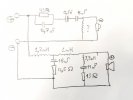I like what Erin does a lot - taking detailed measurements and correlating them with what he hears, and explaining to his audience the value of measurements. He provides a great service to us enthusiasts.
Having said that, I do not agree that the measurement axis explains the discrepancy between his results and Amir's results
as far as the woofer level is concerned.
Yes, as he shows, the dip and bump at the 1.4kHz crossover changes considerably as one moves up and down for the measurement axis. So that can explain the differences seen around the 1.4kHz crossover. I'm not so concerned with that.
And I'm not concerned with the small measured differences in the treble region, either between Erin's two samples or Erin's data versus Amir's data. Those are small, narrow, and can be explained by production tolerances of the mechanical assembly of the compression tweeter, the waveguide, and the tolerances of the rather complex analog EQ done by the crossover.
But the overall woofer output level does not change enough to account for the measured differences, at least to my viewing of the data.
From Amir's review (
https://www.audiosciencereview.com/forum/index.php?threads/jbl-studio-530-speaker-review.12298/), we get this graph for off axis vertical response, which shows the expected significant variation around the crossover region as you move up and down. Change Amir's data by a few degrees and you get a lot closer to Erin's data showing the dip and peak
in the crossover region.
But there is just a little (2dB or so) difference in overall woofer response even if one goes way off axis (+40 degrees, the dark blue trace). And if you do go that far off axis, then the treble output is rolled off by several dB (6 to 8 dB or so), which would be very different from Erin's results.
Take the response at 800Hz as an example. No matter the angle, the output barely changes. as shown in the graph above. Yet Amir's results are maybe 3 dB higher there than Erin's results. This can't be explained by measurement angle alone. Same goes for the region around 100 to 200Hz, and really for the entire bass region.
Measurement angle is critical for the crossover region, and to a large extent for the treble region, but much less so for the bass.
I don't do much on Youtube, but if Erin is reading this or somebody wants to comment on his Youtube video, ask him if he has results of the impedance for the Studio 530s that he measured.





